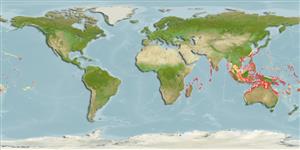>
Carangiformes (Jacks) >
Carangidae (Jacks and pompanos) > Caranginae
Etymology: Caranx: French, carangue, the name of a Caribbean fish; 1836 (Ref. 45335).
More on authors: Alleyne & MacLeay.
Environment: milieu / climate zone / depth range / distribution range
Écologie
marin; saumâtre récifal; non migrateur; profondeur 1 - 50 m (Ref. 89972). Tropical; 31°N - 34°S, 26°E - 135°W
Indo-Pacific: Zanzibar, Tanzania and South Africa to Caroline and Marquesan islands, north to the Ryukyu Islands, south to Australia.
Taille / Poids / Âge
Maturity: Lm ? range ? - ? cm
Max length : 88.0 cm TL mâle / non sexé; (Ref. 9710); common length : 55.0 cm FL mâle / non sexé; (Ref. 3287); poids max. publié: 6.4 kg (Ref. 4699)
Épines dorsales (Total): 9; Rayons mous dorsaux (Total): 21-23; Épines anales 3; Rayons mous anaux: 16 - 19. Brassy to yellowish green dorsally, shading to silvery on side with scattered dark spots (becoming more numerous with age), conspicuous silvery white spot just behind upper rear edge of opercle, dusky upper caudal fin lobe, and bright yellow to dusky lower lobe with narrow white border (Ref. 90102, Ref. 48635). Body oblong and compressed; dorsal profile moderately convex to second dorsal fin, ventral profile slightly convex. Breast scaleless ventrally, usually with small patch of prepelvic scales. Adipose eyelid weakly developed. (Ref. 90102)
Inhabit lagoon and seaward reefs, occasionally entering rivers. Juveniles found in estuaries. Swims high over bottom (Ref. 48635). Solitary or in schools (Ref. 90102). Feed primarily on fishes. Excellent food fish (Ref. 12484).
Life cycle and mating behavior
Maturité | Reproduction | Frai | Œufs | Fécondité | Larves
Oviparous, distinct pairing during breeding (Ref. 205).
Paxton, J.R., D.F. Hoese, G.R. Allen and J.E. Hanley, 1989. Pisces. Petromyzontidae to Carangidae. Zoological Catalogue of Australia, Vol. 7. Australian Government Publishing Service, Canberra, 665 p. (Ref. 7300)
Statut dans la liste rouge de l'IUCN (Ref. 130435)
Menace pour l'homme
Harmless
Utilisations par l'homme
Pêcheries: intérêt commercial mineur; Aquaculture: commercial; pêche sportive: oui
Plus d'informations
RéférencesAquacultureProfil d'aquacultureSouchesGénétiqueElectrophoresesHéritabilitéPathologiesTraitementNutrientsMass conversion
Outils
Articles particuliers
Télécharger en XML
Sources Internet
Estimates based on models
Preferred temperature (Ref.
123201): 24.5 - 28.8, mean 27.6 °C (based on 586 cells).
Phylogenetic diversity index (Ref.
82804): PD
50 = 0.5000 [Uniqueness, from 0.5 = low to 2.0 = high].
Bayesian length-weight: a=0.01738 (0.01108 - 0.02725), b=2.96 (2.84 - 3.08), in cm total length, based on LWR estimates for this species & Genus-body shape (Ref.
93245).
Niveau trophique (Ref.
69278): 4.0 ±0.5 se; based on diet studies.
Résilience (Ref.
120179): Milieu, temps minimum de doublement de population : 1,4 à 4,4 années (Preliminary K or Fecundity.).
Fishing Vulnerability (Ref.
59153): High vulnerability (55 of 100).
Nutrients (Ref.
124155): Calcium = 24.2 [11.1, 46.5] mg/100g; Iron = 0.426 [0.232, 0.830] mg/100g; Protein = 20.3 [18.1, 22.7] %; Omega3 = 0.129 [0.076, 0.224] g/100g; Selenium = 45.2 [22.5, 100.3] μg/100g; VitaminA = 45.9 [14.4, 142.2] μg/100g; Zinc = 0.531 [0.376, 0.785] mg/100g (wet weight);
